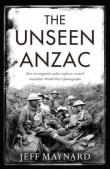 5530977121969125815.jpg
5530977121969125815.jpg
 The Unseen Anzac : How an Enigmatic Explorer Created Australia's World War I Photographs
single work
The Unseen Anzac : How an Enigmatic Explorer Created Australia's World War I Photographs
single work
 5530977121969125815.jpg
5530977121969125815.jpg
 The Unseen Anzac : How an Enigmatic Explorer Created Australia's World War I Photographs
single work
The Unseen Anzac : How an Enigmatic Explorer Created Australia's World War I Photographs
single work
'Cameras were banned at the Western Front when the Anzacs arrived in 1916. Only official photographers were permitted to take propaganda pictures. Fearing the Anzacs would be ignored, correspondent Charles Bean continually argued for Australia to have a dedicated photographer. He was eventually assigned an enigmatic polar explorer—George Hubert Wilkins.
'Within weeks of arriving at the front Wilkins’ exploits were legendary. He did what no photographer had previously dared to do. He went ‘over the top’ with the troops and ran forward to photograph the actual fighting. He led soldiers into battle, captured German prisoners, was wounded repeatedly and twice awarded the Military Cross—all while he refused to carry a gun and only armed himself with a bulky, glass-plate camera. Wilkins ultimately produced the most detailed and accurate collection of World War I photographs in the world, which is now held at the Australian War Memorial.
'After the war Wilkins returned to exploring and, over the next forty years, his life became shrouded in secrecy. His work at the Western Front was forgotten as others claimed credit for his photographs. Throughout his life Wilkins wrote detailed diaries and letters, but when he died in 1958 these documents were locked away. Many were only discovered in 2013. Jeff Maynard follows a trail of myth and misinformation to locate Wilkins’ lost records and reveal the remarkable true story of Australia’s greatest war photographer. ' (Publication summary)
'This is an absorbing book about an astonishing Australian whose under-recognition is a national embarrassment. H. G. Wilkins was an intrepid polar explorer, an outstanding war photographer, an innovative research scientist, a resourceful engineer, pilot and geographer, and much else besides. Unfailingly dedicated and principled, Wilkins was also modest and elusive, quirky and enigmatic. He was so extraordinary at the Western Front that John Monash kept describing him as the bravest man in the AIF until Wilkins asked Monash to stop' (Introduction)
'This is an absorbing book about an astonishing Australian whose under-recognition is a national embarrassment. H. G. Wilkins was an intrepid polar explorer, an outstanding war photographer, an innovative research scientist, a resourceful engineer, pilot and geographer, and much else besides. Unfailingly dedicated and principled, Wilkins was also modest and elusive, quirky and enigmatic. He was so extraordinary at the Western Front that John Monash kept describing him as the bravest man in the AIF until Wilkins asked Monash to stop' (Introduction)